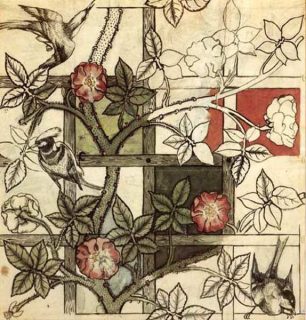The Trellis and the Rose
This reflection by our Spiritual Accompanier Sr. Rosemary SLG is an abridged version of her Talk at the Community Weekend.

Here is a story from the desert fathers:
Abba Lot went to see Abba Joseph and said to him, “Abba, as far as I can I say my little office, I fast a little, I pray and meditate, I live in peace and as far as I can, I purify my thoughts. What else can I do?” then the old man stood up and stretched his hands towards heaven. His fingers became like ten lamps of fire and he said to him, “If you will, you can become all flame.”
Fasting, prayer, meditation, living in peace and, as far as you can, purifying your thoughts – these are excellent spiritual disciplines, a good trellis, but the point is ‘becoming all flame’. In that story it is clear that the point is to become all flame, and we can say that the flames are the roses.
Is that what is Contemplative Fire about, ‘becoming all flame’? Is that why you came this weekend? Or if not, how would you put it? What do you want from Contemplative Fire? Is there a word, an image, a memory, or a mood that expresses it? For now just ask yourself the question, ‘what am I wanting from Contemplative Fire?’ And if you feel there could be more behind your first answer, try wondering, now or later, why you want this or that.
The Trefoil
Contemplative Fire does not have a Rule of Life but it does have the Trefoil which indicates the character of the life you are seeking to live and the sort of practices which shape it. It is not as simple, I think, as saying that the Trefoil is your Rule, your trellis, and your lives are the roses; the Trefoil is, sort of, both roses and trellis. It doesn’t set out requirements for being a Companion, and it doesn’t give a set of structures to support Companions, Friends and others in their spiritual lives; rather, it delineates a vision which can be expressed in, and accompanied by, a range of practices.
The leaves in the Trefoil give three different sections to explore and suggest a variety of ways in which to do so. There is a whole range of options. Thus, like most monastic rules, the Trefoil vitally allows for the differences between people, and how we are different at different stages of our lives – there is room for everyone. One of the most noticeable characteristics of Contemplative Fire is the stress upon proper respect for each person, their values, language, experience and aspirations. To undertake all of the suggestions on the website, and even to try them out for a bit, would be to take on too much, and would be unlikely to bear fruit. But you are invited and expected to make all three elements, and the central inner space, recognizably part of your lives. I wonder how you do that and whether it is something you discuss with each other? The vision set out in the Trefoil is simple and difficult, requiring a good deal of self-knowledge, discernment and, probably, help from each other in order to make the most of it.
Probably each of you will have found one or other of the ‘leaves’ of the Trefoil more congenial than the other two, but it is not enough to stay in what comes easily. As a friend of mine used to say, getting stuck in a rut is like being in a coffin with the ends knocked out! So the ribbon or pathway threading through the Trefoil, weaving up and down, creating and defining the pattern, is vital. The Trefoil invites you to move steadily through each of the shapes in a rhythm of embracing and letting go, so as to maintain and deepen the still centre. By breaking and re-finding the balance you can yield to the rhythm with increasing confidence.
Have you found that? Or do you find that is it more the case that they come together as one thing? Does the Trefoil indicate a form of spiral learning, and if so what do you learn? Are you being deepened and enlarged in the process? And is it this combination of doing and being and learning that forms you into a distinctive community? Let’s pause again so that you can reflect for a moment, in silence, on your personal experience of living the Trefoil in the ups and downs of your life.
Walking the talk
The Trefoil has a certain runic quality, but it is not magic and it may not always work for you. As you were reflecting just now, it’s possible that some of you found yourselves asking whether the Trefoil is enough to keep Contemplative Fire together, and enough to bring wholeness and integrity to your personal life. The obvious answer to that is, ‘Of course not!’
I say that from my experience of trying to live the Rule and Way of Life of the Sisters of the Love of God. I’ve had plenty of time to try and I hope to have a good few years more to keep trying, but I don’t think it is ever going to be do-able. Realizing that is quite a relief! I’m not just talking about monastic life or the life of a community like mine. This is about Christian life, and we cannot ‘do it’ because Christian life is a matter of grace, grace upon grace, and the grace to receive the grace that is given. Not what we can do or achieve but what God gives us is the mystery that reveals and sustains our life in Christ. In an important sense, grace is the ‘foundational component’ of our lives and it is grace which, together with our determined commitment and the particular circumstances of our lives, brings forth fruit, and roses. Hence the space in the centre of the Trefoil.
As I have gone on thinking about it, I have come back again and again to the importance of perseverance in order to allow grace to work. Growth takes time, we are time-bound creatures and we just have to come to terms with that and be patient. Every spiritual tradition is aware that this is how it is, we are on a spiritual journey. We have a goal and we set out, or like Abraham we set out in faith not knowing where we are going. Either way we have to make the journey. Long and tested tradition identifies three stages, or states of soul, along the way: purgation (purification), illumination and union. We may touch briefly into each of them, not necessarily in the prescribed order, even in a single day, and more than once as our pilgrimage continues and as we go deeper. It seems that having known the merest touch of union we never entirely lose our longing for its fullness, however obscurely we realize that. We may not be ready yet, it takes time to integrate our intuitions, but the first touch is enough to lure us on until we learn how to bear ‘the beams of love’ (William Blake, The Little Black Boy). God is in control of the process and God always deals with us gently, with due order, and in the way that is appropriate for each person, as St John of the Cross affirms in the Ascent of Mount Carmel (Book II, chapter 17).

